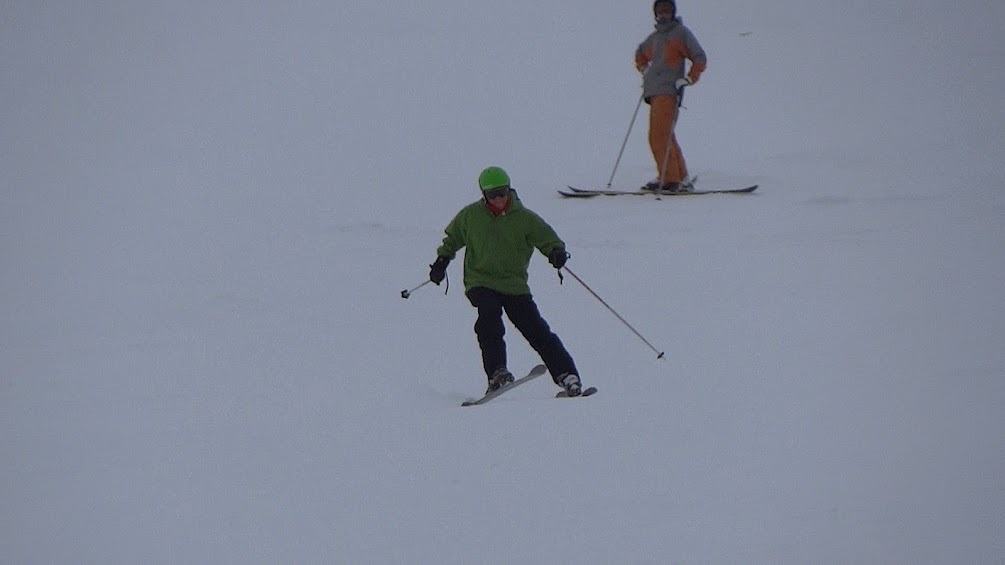One Leg
Today began with a red run all the way down to Meribel Mottaret. To deal with the slightly icy steep slopes I tried to address the most obvious individual weaknesses. Tibo was the most precarious so I started with him – making sure that he understood how the uphill ski is pressured through dynamics from the very start of the turn. Initially, with me standing downhill and getting him to lean against me, he was using the wrong edges to try to push against me (remaining on the uphill edges). We corrected this so that he could properly push against me and feel how dynamics would generate the pressure (when my presence is replaced with angular accelerations). The theme emerging here for everyone was the importance of establishing pressure from the top of the turn and not just trying to get the ski downhill and then brake.
Wide Stance
This issue was equally important for all the others as everyone tended to rush the start of the turn and avoid getting pressure on the ski through a strong support from the leg. To aid the process I demonstrated how a wide stance enabled a rapid and easy switch from one leg to the other with a smaller movement of the centre of mass than if the feet are together. I explained that the body has to always be set up so as to stand on one leg – even if two are on the ground or even if the wrong leg is stood on inadvertently. If the body is correctly oriented towards the outside leg it will be fine. Narrow stance skiing is only for specific purposes and should generally be avoided until a good independence of the legs is first developed.
Seated Stance
Tibo was still very stiff and Luke not far behind so I had them remove skis and adopt a seated stance facing downhill. This exercise demonstrates the feeling of a relaxed flexed position with no leaning against the boots and no tendency to fall backwards. The feet and knees are also ahead of the body and so very protective. Until now when facing downhill they both had resorted to tensing the legs and levering against the backs of the boots. When you feel this happen the solution is to sit slightly and look for the shin making light contact with the front of the boot due to relaxing the knee and hip joints. Both were struggling with being centred on the skis.
Foot Forwards
For skiing down an even steeper icy slope back down into Courchevel I had everyone remove skis again and work on pushing the outside foot forwards. Static exercises were done and Luke had trouble generating angulation even in the static exercise – specifically at the end of the simulated turns with the boot edges on the snow. Florence had some initial coordination issues and seemed relatively unaware of what her body was doing. When skiing down Leonie had much more control and grip due to adding the push forwards to her dynamics. Those two things are how a turn radius is determined. On steep terrain the dynamics have to be greater and the push forward amplified accordingly. Pushing forwards causes the ski to tighten up the turn radius – it doesn’t send the foot ahead. Florence did well overcoming her apprehension. Later on she psyched herself out of turning on an easier slope just through negative chatter in her head about it being a “black run”. You have to monitor your own internal dialogue and modify it accordingly because this is how your unconscious mind is programmed – by listening to this dialogue.
Skating
The video clip shows the results of working on skating turn exercises. Tibo, the weakest of the skiers with only a week of previous skiing was by far the strongest with skating – resulting from an ice skating background. This demonstrates my assertion that skating is fundamental to skiing – second only to dynamics. We worked on several exercises – from just skating uphill from the lower ski to complete a turn to skating into a turn from the uphill ski and then skating inwards from the outside ski all the way around. Florence found this a bit muddling but this is reflection on her own ideas of how a turn is constructed and what constitutes the different phases of a turn. Skiing is deceptive in many ways and requires a great deal of reflection. Perception alters in steps though a combination of experience and understanding. Gravity alone is still not properly understood by physics and even Newton’s laws are incredibly counter-intuitive – especially the 3rd law.
Luke with skis converging strongly instead of diverging and on the right with a clear issue of leaning back against the boots.
Luke rotated and leaning back in the boots then on the right with no angulation. Luke’s number one issue that must be resolved is his difficulty in being centred over one foot. (perpendicular to the skis)
Leonie with skis converging instead of diverging – making angulation hard to achieve – needs to be more aggressive. Florence catching the outside edge of her downhill ski and then stepping on top of it… normal coordination glitch.
Tibo showing great hip angulation and diverging skis – looking like a pro! Remember this and bring it into skiing! This IS skiing!
One Ski
The day was finished off with some one-ski skiing with Luke becoming more aware of his issue of being stuck in the back seat. Before you can address an issue you must first become properly aware of it – so this is a step in the right direction.










No comments:
Post a Comment